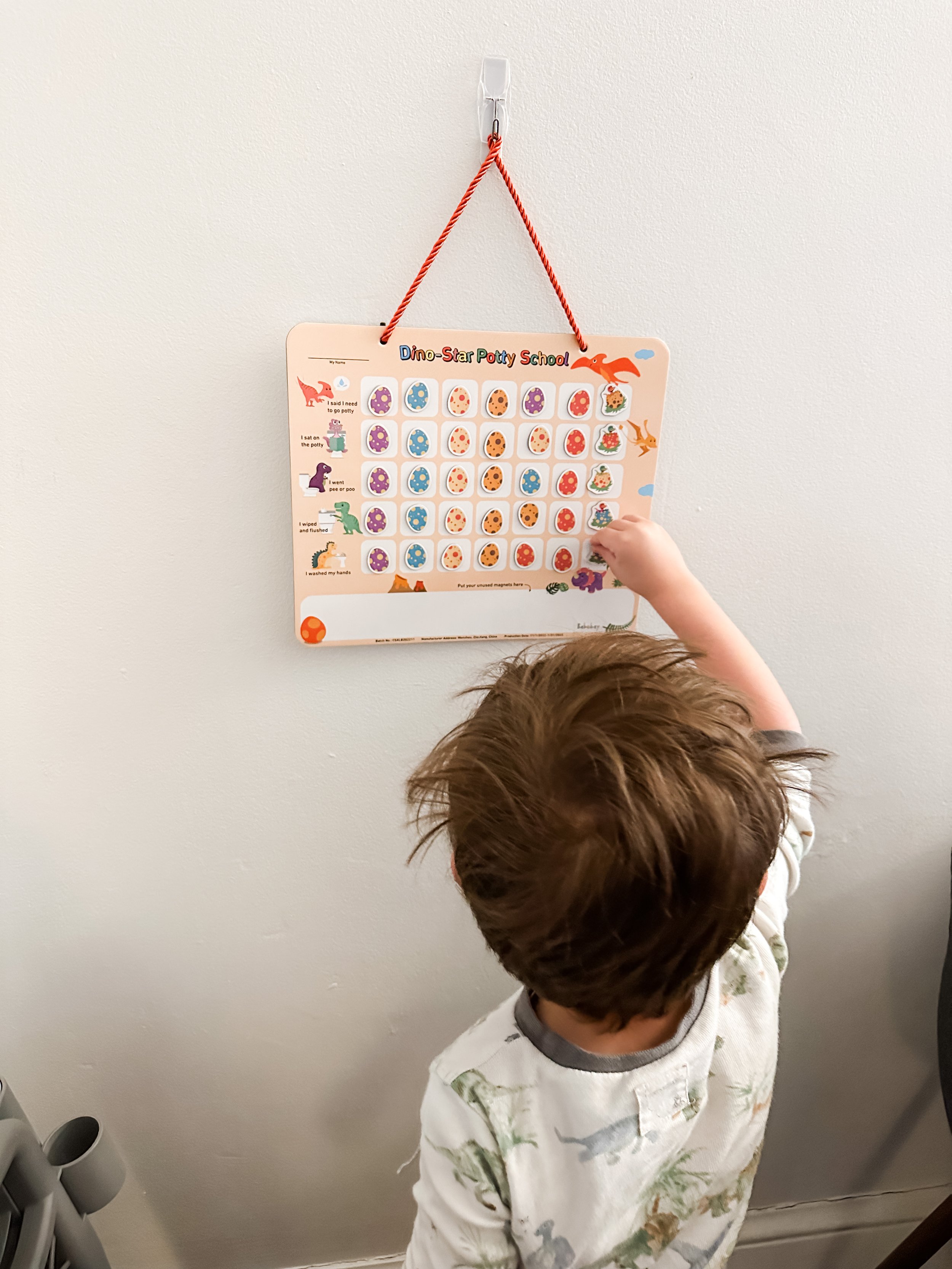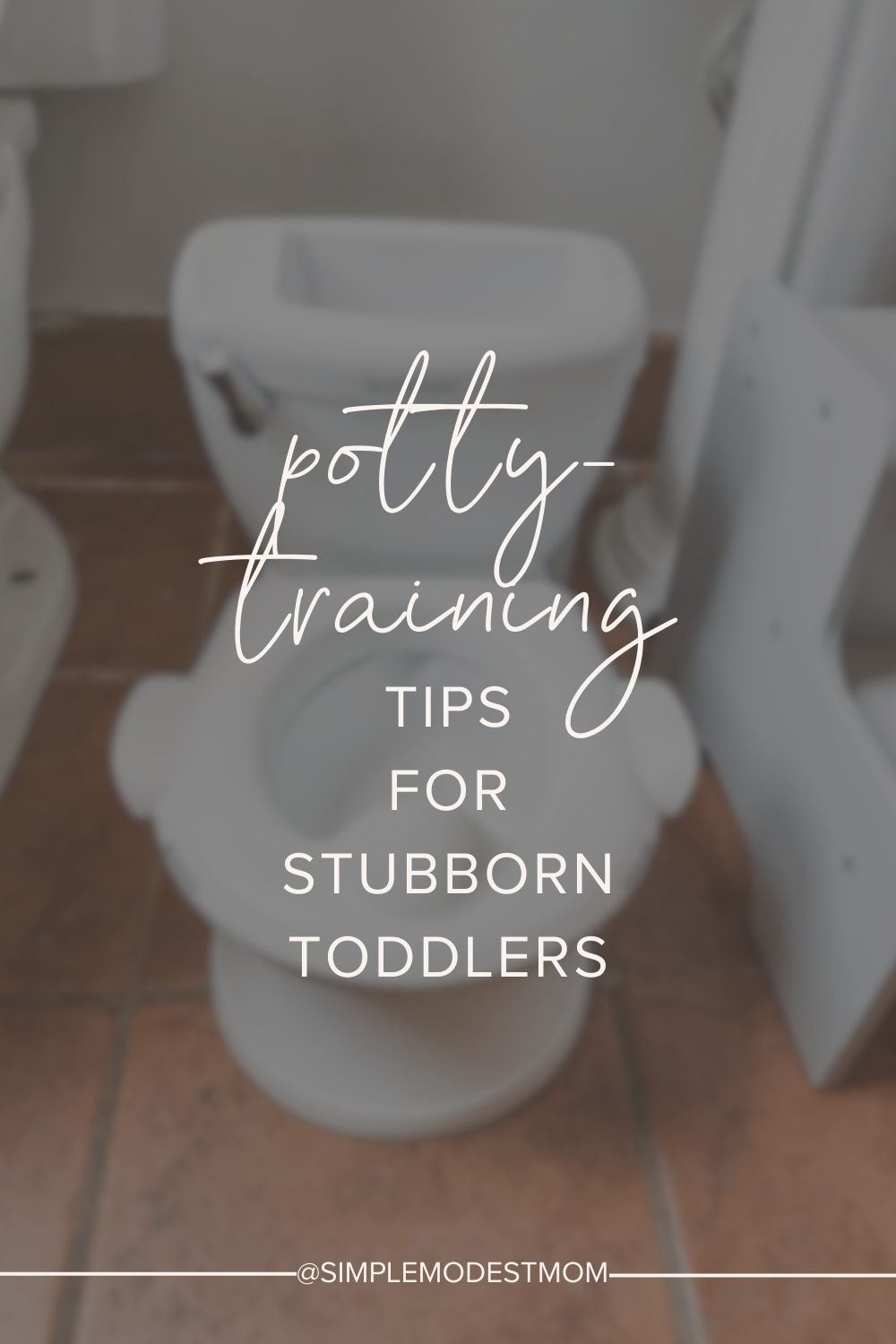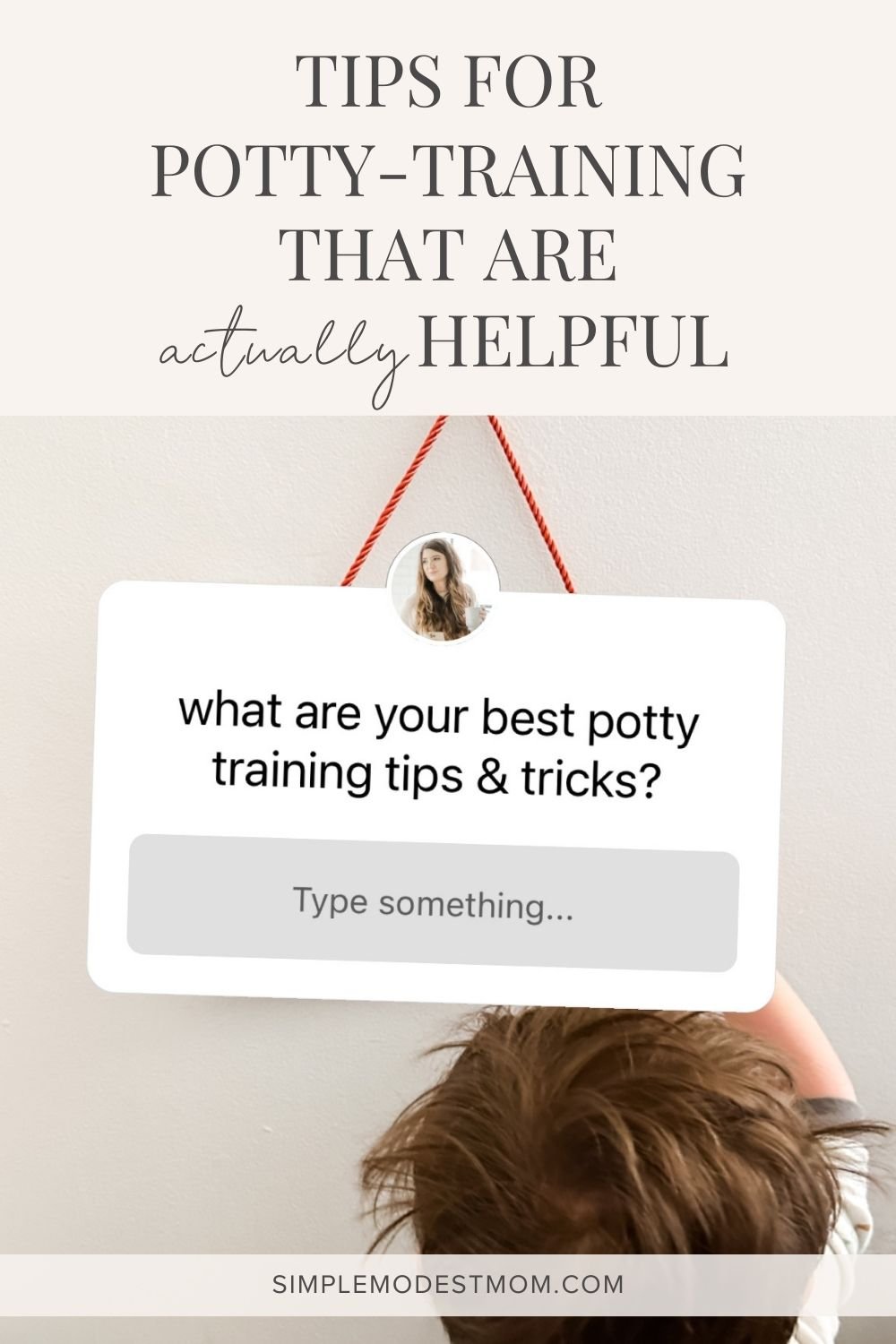Potty Training Tips for Stubborn Toddlers
/This post may contain affiliate links, which means I receive a commission if you choose to purchase through links I provide (at no extra cost to you). Shopping through these links is one small way of supporting this blog, and for that - I thank you! For more information, see my disclosures here.
Is your toddler resisting potty training? Don't give up just yet! Check out these effective tips for potty training stubborn toddlers.
I feel like we have been on QUITE the journey with potty training our 3-year-old toddler boy. I have known for a long time that potty training for boys can naturally take a lot longer than for girls, so in some ways we have not pushed super hard to get him to use the potty consistently before we felt like he was ready. But the longer we waited, the more I felt like he was too comfortable staying in pull-ups and not bothered enough by the feeling of getting wet. When we gave him days of not wearing anything from the waist down (at home, obviously), he would do great understanding when he needed to use the potty (for the most part!). But if we put him back in pull-ups and expected him to know when to use the potty, it was right back to acting uninterested in the entire ordeal. For us, I finally just needed to take the leap and make potty training the only option!
Keep reading to see some of my best tips, tricks & favorite finds from our potty training journey!
Top Tips for Potty-Training Toddlers
Potty training can be a challenging time for both parents and toddlers. If your little one is resisting the process, it can be frustrating and discouraging. However, with some patience and persistence, you can successfully potty train even the most stubborn toddlers. Here are some tips to help make the process smoother and more successful:
Wait for the Right Time
One of the most important things to remember when potty training a stubborn toddler is to wait for the right time - or when you believe they are ready. Every child is different and may be ready to start potty training at different ages. Look for signs that your child is ready, such as showing interest in the toilet or being able to communicate their needs. Trying to force the process before your child is ready can lead to resistance and frustration for both you and your toddler.
Even more importantly… make sure that YOU as the parent are ready! I think this was maybe the biggest hurdle for me mentally - I just had to decide that I was ready to change my own habits and routines as a parent and be ready for it all - the disruptions in my own schedule, the messes that I would have to clean up, the patience to sit and wait while he learned to sit and wait!
Make Potty Training Fun
One way to encourage a stubborn toddler to use the potty is to make it a fun and exciting experience. Try using stickers or a reward chart to track their progress and offer small rewards for successful trips to the bathroom. You can also let them pick out their own special underwear or decorate their potty with stickers or markers. Making potty training a positive and enjoyable experience can help motivate your child to participate and succeed. We found this great magnetic dinosaur potty chart that was a great starter chart for us! We loved being able to see the progress and move the magnet eggs around easily. At one point, we knew that we needed something just a little bit different, so I ended up making our own potty chart to track going to the potty, but also allowed us to specifically track days that he stayed dry all day and work towards a larger prize!
scroll to shop potty charts
Let your toddler choose whether they want to use a potty chair or the regular toilet. Giving them choices can help them feel more in control. We made sure to get several potty seat options, and I didn’t push too hard to make him use one that he was uncomfortable with! So far his favorite has been the small potty that looks exactly like our big potty. We also have a step-ladder toilet seat, but as of now he doesn’t feel comfortable on that, so we don’t push it too hard. When he’s ready, we’ll make sure to transition to that so that he knows how to access the regular toilet with ease! We also have a portable fold-up potty seat that can stick to any toilet and has its own storage bag that makes it easy to take with us. That seat makes him feel so much more comfortable using public toilets when we travel!
scroll to shop potty seats
Another way to make potty training fun is to offer some fun training underwear! Getting your toddler out of pull-ups and into cloth underwear will be important for their potty training process. We started with specific training underwear that was more padded and could hold more liquid when there were accidents in the beginning, and then moved on to regular toddler underwear that we let him pick out!
scroll to shop fun toddler training underwear
Use Positive Reinforcement
Positive reinforcement is a powerful tool when it comes to potty training stubborn toddlers. Instead of punishing your child for accidents or resistance, focus on praising and rewarding them for their successes. This can include verbal praise, high-fives, or small treats like stickers or a favorite snack. By emphasizing the positive aspects of potty training, you can help your child feel more motivated and confident in their abilities.
Be Consistent
Consistency is key when it comes to potty training stubborn toddlers. Establish a routine and stick to it as much as possible. This includes taking your child to the bathroom at regular intervals, such as every hour or after meals and naps. Set a regular schedule for your toddler to use the potty. Try to have them sit on the potty at the same time each day. You could even get a designated timer for potty time and every time it goes off, it’s time for your child to sit on the potty (whether they have to go or not!). Consistency also means using the same language and approach every time, so your child knows what to expect and what is expected of them. It may take some time and patience, but with consistency, your child will eventually develop good potty habits.
scroll to shop potty timers
Another part of being consistent is also being prepared for going to the potty on-the-go! There are some great potty seats for traveling that you can keep in the car, with accessories like baggies and pee pads to go with the potty seats. You can even get a fancy pop-up changing room that you can use anywhere you need to when you have to pull over to use that potty seat.
scroll to shop on-the-go potties and accessories
Be Patient & Prepare for Accidents
Potty training can take time and accidents will happen. Watch for signs that your toddler needs to go potty, such as fidgeting or crossing their legs. Encourage them to use the potty as soon as they show signs. Be patient and understanding with your toddler and avoid punishing them for accidents. Stay positive and keep encouraging your child.
Some of the best accident prep comes with having wet bags on hand to gather up any wet clothes from accidents, keeping backup outfits on hand at all times, use waterproof blankets or mats on the bed or couch to save yourself some washing, and keeping a quality stain remover on hand!
scroll to shop potty-training prep must-haves
Know When To Get Help
Potty Training can potentially be a really frustrating journey - for both the child and the parents! While most of the time potty-training is not always a weekend success story, if you feel like potty-training is increasingly difficult or if your child is showing signs of resistance, it may be helpful to consult with your pediatrician for additional tips and advice.
Frequently Asked Questions about Potty-Training
When should I start potty training my toddler? / How do I know if my toddler is ready to start potty training?
Parents should start potty training their toddler when they show signs of readiness, such as staying dry for longer periods, expressing interest in using the toilet, and having regular bowel movements, usually around 18-24 months of age.My toddler is resistant to potty training, what can I do?
If your toddler is resistant to potty training, there are several strategies you can try to gently encourage and motivate them, including consistency, positive reinforcement, patience, and making potty training a fun and interactive experience.How long does it typically take to potty-train a toddler?
On average, it takes several months to fully potty train a toddler, as it involves teaching them new skills, establishing routines, and gradually transitioning from diapers to using the toilet independently.What are some signs that my toddler needs to go potty?
Some signs that your toddler needs to go potty include squirming or fidgeting, holding their crotch or crossing their legs, making potty-related comments or gestures, displaying restlessness or sudden irritability, or suddenly stopping their activities to find a secluded spot.Should I use a reward system to encourage my toddler to use the potty?
A reward system can be an effective tool to encourage your toddler to use the potty, but it should be used in conjunction with positive reinforcement and gentle guidance to ensure long-term success.What should I do if my toddler has an accident?
If your toddler has an accident, stay calm, comfort them, clean up the mess, and help them learn and understand how to handle accidents in the future.How do I transition my toddler from diapers to underwear?
To transition your toddler from diapers to underwear, start with introducing potty training gradually, ensuring consistency, using positive reinforcement, and being patient throughout the process. You can often make new underwear a really exciting thing and let your toddler pick out some designs that they are most excited about!Should I use a potty chair or a toilet seat insert for potty training?
When deciding between a potty chair or a toilet seat insert for potty training, the choice ultimately depends on your child's needs and preferences, with a potty chair offering more convenience and comfort for younger toddlers, while a toilet seat insert promotes a smoother transition to using the regular toilet.My toddler will only go potty at home, what should I do when we’re out and about?
If your toddler will only go potty at home, it might be helpful to gradually introduce them to using public restrooms by taking them to familiar places with clean facilities or using portable travel potties until they feel more comfortable doing it outside of the home.Should I wake my toddler up at night to go potty?
Whether or not to wake your toddler up at night to go potty depends on their age, development, and individual needs, so it is essential to consider their overall well-being and the potential impact on their sleep patterns before making a decision. It often takes much longer to stay dry all night long, so continuing to wear an overnight pull-up can save everyone some headaches.How do I handle regression in potty training?
To effectively handle regression in potty training, parents should remain patient, provide consistent routines, offer positive reinforcement, and address underlying causes such as stress or changes in routine. When we had spells of regression, I often did what was “easy” for me and took the pressure off my toddler, and then waited a few days (or weeks) to start all over again. I knew that adding extra pressure or getting upset would make things harder for my toddler and for me as the parent!What if my toddler doesn’t want to sit on the potty for more than a few seconds?
If your toddler is resistant to sitting on the potty for longer durations, it may be helpful to employ creative strategies, reinforce positive behavior, and remain patient and consistent throughout the potty training process. We often make sure to have a stack of books beside the potty, his tablet nearby, or let him take his dinosaurs or monster trucks to play with while sitting and waiting. We have also created a potty area in our living room in front of the TV so that he has quick and easy access to sit on the potty and will stay there longer!How do I teach my toddler to wipe properly?
To teach your toddler to wipe properly, introduce them to the concept of wiping, demonstrate and guide them in the correct technique, provide them with child-friendly wipes or toilet paper, and consistently reinforce and praise their efforts. We love having toddler-friendly flushable wipes available for comfort, but we also practice pulling off “squares” of regular toilet paper to use as well!How do I help my toddler with constipation or other bathroom issues during potty training?
To help your toddler with constipation or other bathroom issues during potty training, try incorporating high-fiber foods, offering plenty of fluids, establishing a consistent potty routine, creating a comfortable environment, and being patient and supportive throughout the process. You can also try using a daily prebiotic like Begin Health (we use this for our kids and love it!) - If you want to try Begin Health, make sure to use code SIMPLEMODESTMOM to get 10% off your order!







































